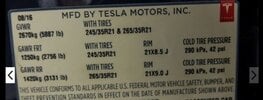Hello All!
So I am receiving my MSP100D, August 2016 build, 95k miles tomorrow. I have read on here tons of the threads about battery failure and the exorbitant costs associated with replacement. I have also read the average of about 10% degradation at 100k miles (not a problem for us) and about 15k for 200k miles. I have looked, and maybe missed, total battery failure numbers [if they even are published] as a percent of totals. As in, for every 250,000 100kwh batteries produced, 1,000 will fail. Or whatever numbers. Thus, my question for the forum is [ESPECIALLY those around this year and model and battery pack] what have been your experiences? Total failures? 5, 10, 15, 20% degradation? Still operating wonderfully? Any stories would be great! Thanks in advance!
EDIT: For addtl background, was originally owned as personal vehicle, averaged about 8k/year miles. Last four years approx 18k/year miles as a fleet vehicle.
So I am receiving my MSP100D, August 2016 build, 95k miles tomorrow. I have read on here tons of the threads about battery failure and the exorbitant costs associated with replacement. I have also read the average of about 10% degradation at 100k miles (not a problem for us) and about 15k for 200k miles. I have looked, and maybe missed, total battery failure numbers [if they even are published] as a percent of totals. As in, for every 250,000 100kwh batteries produced, 1,000 will fail. Or whatever numbers. Thus, my question for the forum is [ESPECIALLY those around this year and model and battery pack] what have been your experiences? Total failures? 5, 10, 15, 20% degradation? Still operating wonderfully? Any stories would be great! Thanks in advance!
EDIT: For addtl background, was originally owned as personal vehicle, averaged about 8k/year miles. Last four years approx 18k/year miles as a fleet vehicle.
Last edited:




